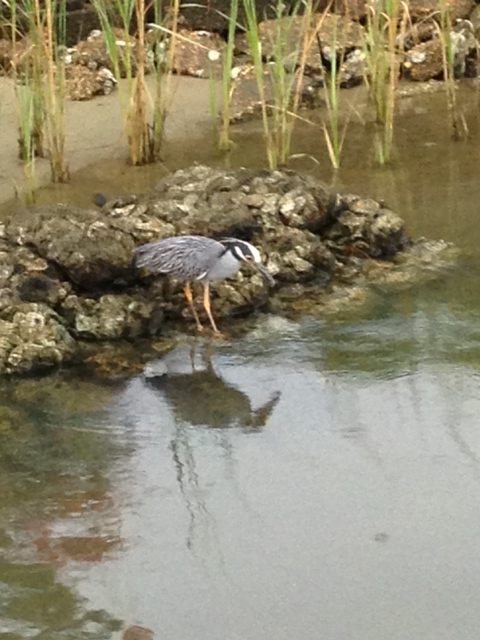
by Rick O'Connor | Apr 18, 2019
Oysters are like snakes… you either like them or you hate them. You rarely hear someone say – “yea, their okay”. It’s either I can’t get enough of them, or they are the most disgusting thing in the sea.
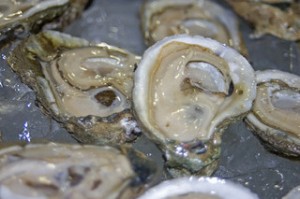
Courtesy of Florida Sea Grant
That said, they are part of our culture. Growing up here in the Florida panhandle, there were oyster houses everywhere. They are as common on menus as French fries or coleslaw. Some like them raw, some like them in gumbo or stews, others are fried oyster fans. But whether you eat them or not, you are aware of them. They are part of being in the northern Gulf of Mexico.
In recent decades the historic oyster beds that supported so many families over the years have declined in production. There are a variety of stressors triggering this. Increased sedimentation, decreased salinity, overharvesting, not returning old shell to produce new reefs, and many more. The capitol of northwest Florida’s oyster coast is Apalachicola. Many are aware of the decline of harvest there. Certainly, impacted by the “water wars” between our state and Georgia, there are other reasons why this fishery has declined. I had a recent conversation with a local in Apalachicola who mentioned they had one of their worst harvest on record this past year. Things are really bad there.
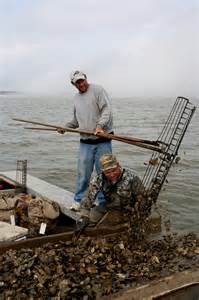
An oysterman uses his 11 foot long tongs to collect oysters from the bottom of Apalachicola Bay
Photo: Sea Grant
Despite the loss of oysters and oyster habitat, there has not been a decline in the demand for them at local restaurants. There have been efforts by Florida Sea Grant and others to help restore the historic beds, improve water quality, and assist some with the culture of oysters in the panhandle.
Enter the Bream Fisherman’s Association of Pensacola.
This group has been together for a long time and have worked hard to educate and monitor our local waterways. In 2018 they worked with a local oyster grower and the University of West Florida’s Center for Environmental Diagnostics and Bioremediation to develop an oyster garden project called Project Oyster Pensacola. Volunteers were recruited to purchase needed supplies and grow young oysters in cages hanging from their docks. Participants lived on Perdido, Blackwater, East, and Escambia Bays. Bayous Texar, and Grande. As well as Big Lagoon and Santa Rosa Sound. The small, young oysters (spat) were provided by the Pensacola Bay Oyster Company. The volunteers would measure spat growth over an eight-month period beginning in the spring of 2018. In addition, they collected data on temperature, salinity, and dissolved oxygen at their location.
After the first year, the data suggests where the salinity was higher, the oysters grew better. Actually, low salinity proved to be lethal to many of them. This is a bit concerning when considering the increase rainfall our community has witnessed over the last two years. Despite an interest in doing so, the volunteers were not allowed to keep their oysters for consumption. Permits required that the oysters be placed on permitted living shoreline projects throughout the Pensacola Bay area.
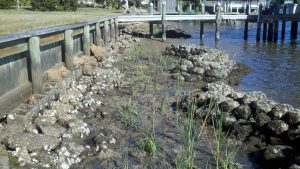
Oyster bags used in a bulkhead restoration project.
Photo: Florida Department of Environmental Protection
We all know how important oysters are to the commercial seafood industry, but it turns out they are as important to the overall health to the bays ecology. A single oyster has been reported to filter as much as 50 gallons of seawater an hour. This removes sediments and provides improved water clarity for the growth of seagrasses. It has been estimated that seagrasses are vital to at least 80% of the commercially important seafood species. It is well known that seagrasses and salt marshes are full of life. However, studies show that biodiversity and biological production are actually higher in oyster reefs. Again, supporting a booming local recreational fishing industry.
This project proved to be very interesting in it’s first year. BFA will be publishing a final report soon and plan to do a second round. For the oyster lovers in the area, increasing local oysters would be nothing short of wonderful.
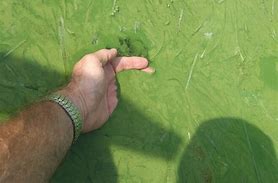
by Rick O'Connor | Aug 17, 2018
Being in the panhandle of Florida you may, or may not, have heard about the water quality issues hindering the southern part of the state. Water discharged from Lake Okeechobee is full of nutrients. These nutrients are coming from agriculture, unmaintained septic tanks, and developed landscaping – among other things. The discharges that head east lead to the Indian River Lagoon and other Intracoastal Waterways. Those heading west, head towards the estuaries of Sarasota Bay and Charlotte Harbor.

A large bloom of blue-green algae (cyanobacteria) in south Florida waters.
Photo: NOAA
Those heading east have created large algal blooms of blue-green algae (cyanobacteria). The blooms are so thick the water has become a slime green color and, in some locations, difficult to wade. Some of developed skin rashes from contacting this water. These algal blooms block needed sunlight for seagrasses, slow water movement, and in the evenings – decrease needed dissolved oxygen. When the algae die, they begin to decompose – thus lower the dissolved oxygen and triggering fish kills. It is a mess – both environmentally and economically.
On the west coast, there are red tides. These naturally occurring events happen most years in southwest Florida. They form offshore and vary in intensity from year to year. Some years beachcombers and fishermen barely notice them, other years it is difficult for people to walk the beaches. This year is one of the worst in recent memories. The increase in intensity is believed to be triggered by the increase in nutrient-filled waters being discharged towards their area.
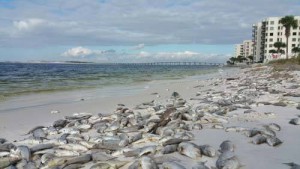
Dead fish line the beaches of Panama City during a red tide event in the past.
Photo: Randy Robinson
On both coasts, the economic impact has been huge and the quality of life for local residents has diminished. Many are pointing the finger at the federal government who, through the Army Corp of Engineers, controls flow in the lake. Others are pointing the finger at shortsighted state government, who have not done enough to provide a reserve to discharge this water, not enforced nutrient loads being discharged by those entities mentioned above. Either way, it is a big problem that has been coming for some time.
As bad as all of this is, how does this impact us here in the Florida panhandle?
Though we are not seeing the impacts central and south Florida are currently experiencing, we are not without our nutrient discharge issues. Most of Florida’s world-class springs are in our part of the state. In recent years, the water within these springs have seen an increase in nutrients. This clouds the water, changing the ecology of these systems and has already affected glass bottom boat tours at some of the classic springs. There has also been a decline in water entering the springs due to excessive withdrawals from neighboring communities. The increase in nutrients are generally from the same sources as those affecting south Florida.
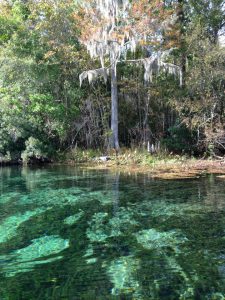
Florida’s springs are world famous. They attracted native Americans and settlers; as well as tourists and locals today.
Photo: Erik Lovestrand
Though we are not seeing large algal blooms in our local estuaries, there are some problems. St. Joe Bay has experienced some algal blooms, and a red tide event, in recent years that has forced the state to shorten the scallop season there – this obviously hurts the local economy. Due to stormwater runoff issues and septic tanks maintenance problems, health advisories are being issued due to high fecal bacteria loads in the water. Some locations in the Pensacola area have levels high enough that advisories must be issued 30% of the time they are sampled – some as often as 40%. Health advisories obviously keep tourists out of those waterways and hurt neighboring businesses as well as lower the quality of life for those living there.
Then of course, there is the Apalachicola River issue. Here, water that normally flows from Georgia into the river, and eventually to the bay, has been held back for water needs in Georgia. This has changed flow and salinity within the bay, which has altered the ecology of the system, and has negatively impacted one of the more successful seafood industries in the state. The entire community of Apalachicola has felt the impact from the decision to hold the water back. Though the impacts may not be as dramatic as those of our cousins in south Florida, we do have our problems.
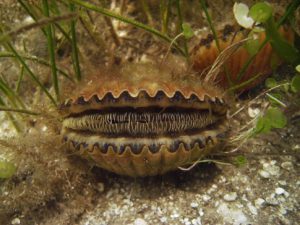
Bay Scallop Argopecten iradians
http://myfwc.com/fishing/saltwater/recreational/bay-scallops/
What can we do about it?
The quick answer is reduce our nutrient input.
The state has adopted Best Management Practices (BMPs) for farmers and ranchers to help them reduce their impact on ground water and surface water contamination from their lands. Many panhandle farmers and ranchers are already implementing these BMPs and others can. We encourage them to participate. Read more at Florida’s Rangeland Agriculture and the Environment: A Natural Partnership – https://nwdistrict.ifas.ufl.edu/nat/2015/07/18/floridas-rangeland-agriculture-and-the-environment-a-natural-partnership/.
As development continues to increase across the state, and in the panhandle, sewage infrastructure is having trouble keeping up. This forces developments to use septic tanks. Many of these septic systems are placed in low-lying areas or in soils where they should not be. Others still are not being maintained property. All of this leads to septic leaks and nutrients entering local waterways. We would encourage local communities to work with new developments to be on municipal sewer lines, and the conversion of septic to sewer in as many existing septic systems as possible. Read more at Maintaining Your Septic Tank – https://nwdistrict.ifas.ufl.edu/nat/2017/04/29/maintain-your-septic-system-to-save-money-and-reduce-water-pollution/.
And then there are the lawns. We all enjoy nice looking lawns. However, many of the landscaping plans include designs that encourage plants that need to be watered and fertilized frequently as well as elevations that encourage runoff from our properties. Following the BMPs of the Florida Friendly Landscaping ProgramTM can help reduce the impact your lawn has on the nutrient loads of neighboring waterways. Read more at Florida Friendly Yards – https://nwdistrict.ifas.ufl.edu/nat/2018/06/08/restoring-the-health-of-pensacola-bay-what-can-you-do-to-help-a-florida-friendly-yard/.
For those who have boats, there is the Clean Boater Program. This program gives advice on how boaters can reduce their impacts on local waterways. Read more at Clean Boater – https://floridadep.gov/fco/cva/content/clean-boater-program.
One last snippet, those who live along the waterways themselves. There is a living shoreline program. The idea is return your shoreline to a more natural state (similar to the concept of Florida Friendly LandscapingTM). Doing so will reduce erosion of your property, enhance local fisheries, as well as reduce the amount of nutrients reaching the waterways from surrounding land. Installing a living shoreline will take some help from your local extension office. The state actually owns the land below the mean high tide line and, thus, you will need permission (a permit) to do so. Like the principals of a Florida Friendly Yard, there are specific plants you should use and they should be planted in a specific zone. Again, your county extension office can help with this. Read more at The Benefits of a Living Shoreline – https://nwdistrict.ifas.ufl.edu/nat/2017/10/06/the-benefits-of-a-living-shoreline/.
Though we may not be experiencing the dramatic problems that our friends in south Florida are currently experiencing, we do have our own problems here in the panhandle – and there is plenty we can do to keep the problems from getting worse. Please consider some of them. You can always contact your local county extension office for more information.
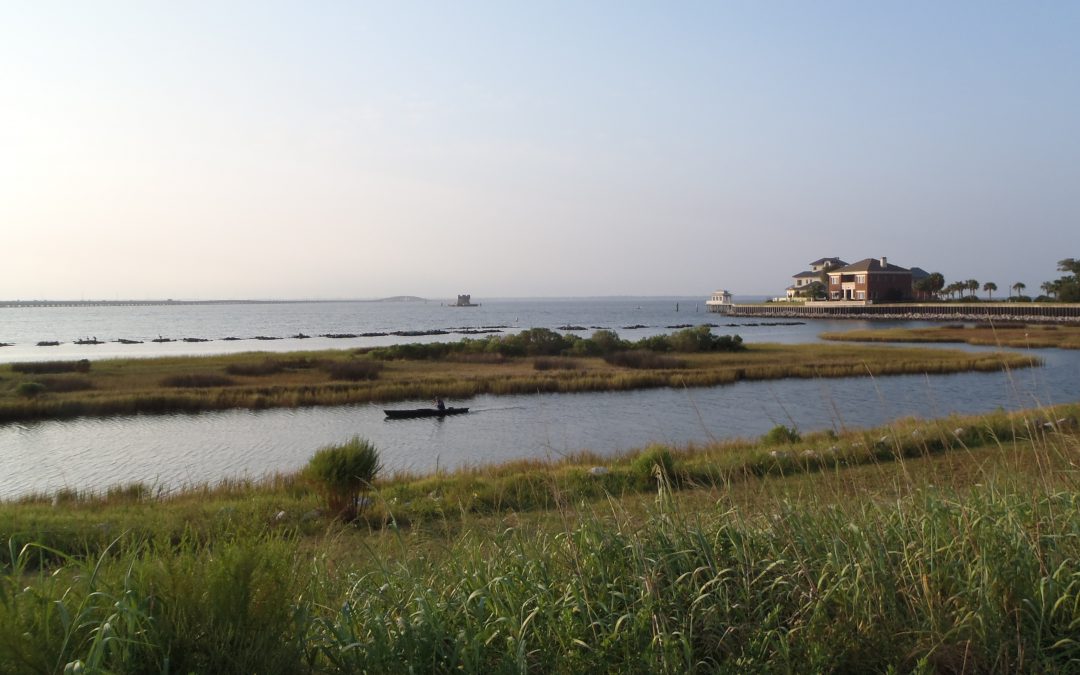
by Rick O'Connor | Oct 6, 2017
Imagine this…
You are a sailor on a 16th century Spanish galleon anchored in a Florida Bay south of Tampa. You, along with others, are ordered to go ashore for a scouting trip to set up a base camp. You transfer over to a small skiff and row ashore to find a forest of root tangled mangroves. There is no dry beach to land so you disembark at the edge of the trees in knee-deep water. The bottom is sandy and your footing is good but you must literally crawl through the tangled mess of mangrove prop roots to finding dry ground. As you do, you encounter spider webs, numerous biting insects, and the bottom becomes muddy and footing is less stable. I am sure I would have returned to the ship to report to the captain that there is nothing of value here – let’s go back to Spain!
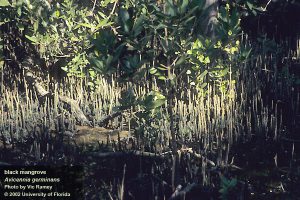
The dense vegetation of a black mangrove swamp in south Florida.
Photo: UF IFAS
Along the shores of northwest Florida it would have been different only that they would have encountered acres of grass instead of trees. The approach to Pensacola would have found a long beach of white sand and dunes. Entering the bay, they would have found salt marshes growing in the protected areas, with the rare exception of dryer bluffs in some spots – which is where de Luna chose to anchor. These marshes are easier to traverse than the emergent root system of the mangrove, but the muck and mire of the muddy bottom and biting insects still remain.
For centuries, Europeans have sought to alter these habitats to make them more suitable for colonization. Whether that was for log forts and houses or marinas and golf courses, we have cleared the vegetation and filled the muck with fill dirt. But have we lost something by doing this?
Yes… Yes we have, and some of what we have lost is valuable to us.
We have lost our water quality.
These emergent shoreline plants filter debris running from shore to the sea during rain events. The muck and mire we encounter within the marsh would otherwise entered the bay or bayou. Here it would cloud the water and smother the submerge seagrasses. My father-in-law told me that as a kid growing up on Bayou Texar in Pensacola he remembered clear water and seagrasses. He remembered throwing a cast net and collecting 4-5″ shrimp.
That has changed.
In our modern world, it is not just mud that is running off towards our bays. We can add lawn fertilizers, lawn and garden pesticides, oils and grease from cleaning, and a multitude of other products – including plastics.
We have seen a decline in living resources.
The large shrimp my father-in-law talked about are not as common. He spoke of snapper – very few now. Bay scallops are basically gone in Pensacola and have declined across much of Florida’s gulf coast. Horseshoe crabs have become rare in many locations. Moreover, salt marsh/mangrove dependent species, such as diamondback terrapins, are difficult to find.
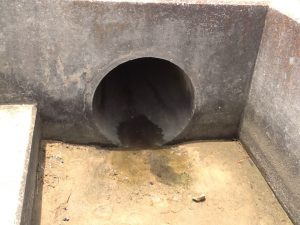
Storm drains, such as this one, discharge run-off into local bays and bayous.
Photo: Rick O’Connor
Maybe of more concern is the decline of commercially important aquatic species such as crabs, shrimp, and finfish. It is known that 80-90% of these commercially important species spend at least part of their lives in the marshes and mangroves.
And this we are losing.
And then there is the shoreline itself.
The emergent plants the Spanish encountered actually act as a wave break. Sand running off the land is trapped to form a “beach”, albeit a mucky one, and the wave energy is absorbed by the plants reducing the energy reaching the shore. The damage in south Florida from hurricane Andrew was devastating. But that same storm made a second landfall in the marshes of Louisiana and there was little to write about – the marsh absorbed much of the energy. The removal of these vegetated shorelines has enhanced the loss of coastline across the Gulf States.
Can we restore these shores and return these “services”?
Yes…
Whether communities want to or not is another question, but we can.
Studies have shown that a marsh 10′ across from water to land can remove 90% of the nutrients running off. Nutrients can trigger hypereutrophic conditions in the bay – which can lead to algal blooms – which can lead to low dissolved oxygen – which can lead to fish kills and seagrass loss. In addition to removing nutrients, marshes and mangroves can remove a variety of other contaminants and plastics. Many sewage treatment facilities discharge their treated effluent through the coastal plant communities before it reaches the bay, thus improving water quality.
We know that restoring a living shoreline will enhance the biological productivity of the bay. Studies have shown that swamps and marshes can produce an annual mean net primary production of between 8000 – 9000 kcal/m2/year, which is equivalent to tropical rainforest and the open estuary itself.
Finally, living shorelines will stabilize erosion issues, much longer than seawalls and other harden structures. Studies have shown that seawalls will eventually give in. Wave energy is increased when it meets the wall and reflects back. This generates higher energy waves that decrease seagrasses and actually begins to remove sediment around the wall itself. You will see the land begin to erode behind the wall and eventually it begins to fall forward into the bay. The east coast of Florida recently experienced this during hurricane Irma. Interestingly the west coast experienced negative tides. The exposure of these seawalls to an empty bay had the same effect. Without the water pressure to hold them, they began to crack and fall forward. A living shoreline can sustain all of this.
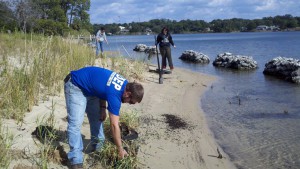
FDEP planting a living shoreline on Bayou Texar in Pensacola.
Photo: FDEP
So how do restore my shoreline?
- You will need a permit. The state of Florida owns land from the mean high tide seaward. To plant above this line you do not need a permit, but you will want to plant at and below to truly restore and benefit from the services. Permitting can be simple or complicated – each property is different. Visit http://escambia.ifas.ufl.edu/permitting-living-shorelines/ to learn more about the process.
- You will need plants. There are a few nurseries that provide the needed species. There is a zonation to the plant community and it is important to put the right plant in the right place. The above link can help with this and the Extension office is happy to visit your location and give recommendations.
- You will need to plant them. Fall and spring are good planting times. A recent project we helped with planted in April and it has been very successful.
- You may want to monitor the success of your project. This not needed, but if interested the Extension office we can show how to do this.I certainly understand why many would rather remove these shoreline ecosystems, but I think you can see the benefits outweigh the problems. It is not an all or none deal. Living shorelines can be designed to allow water access. If interested in learning more contact your county Extension office.
I certainly understand why many would rather remove these shoreline ecosystems, but I think you can see the benefits outweigh the problems. It is not an all or none deal. Living shorelines can be designed to allow water access. If interested in learning more contact your county Extension office.
References
Permitting a Living Shoreline; can a living shoreline work for you? http://escambia.ifas.ufl.edu/permitting-living-shorelines/.
Miller Jr., G.T., S.E. Spoolman. 2011. Living in the Environment: Concepts, Connections, and Solutions. 16th edition. Brooks and Cole Cengage Learning. Pp. 674.
Sharma, S. J. Goff, J. Cebrian, C. Ferraro. 2016. A Hybrid Shoreline Stabilization Technique: Impact of Modified Intertidal Reefs on Marsh Expansion and Nekton Habitat in the Northern Gulf of Mexico. Ecological Engineering 90. Pp 352-360.
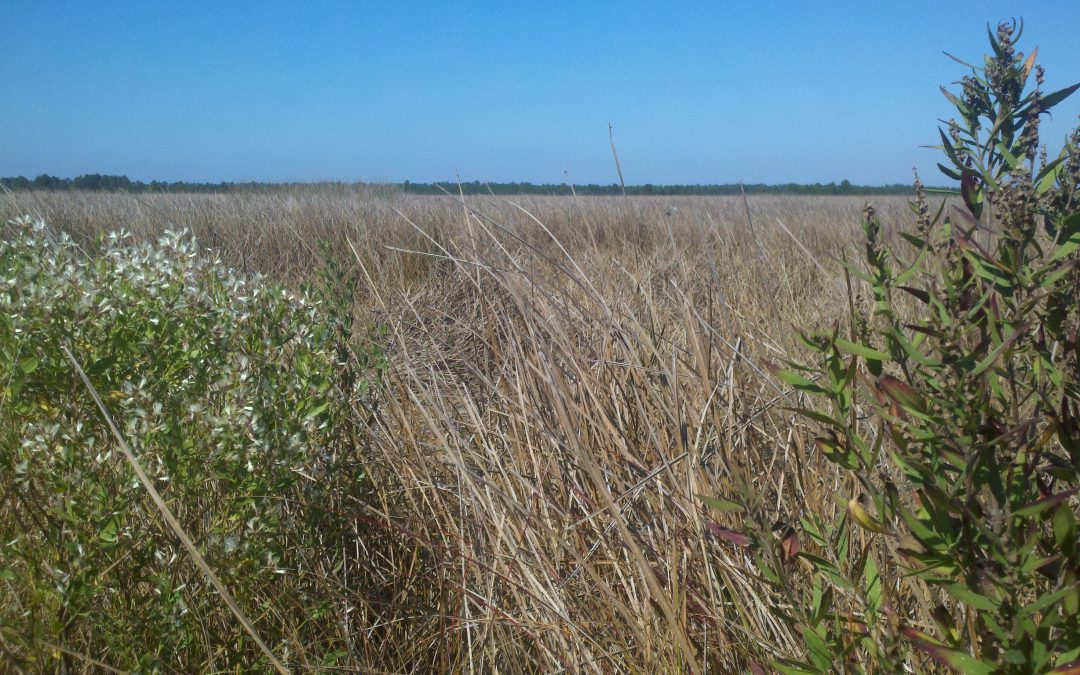
by Carrie Stevenson | Aug 25, 2017
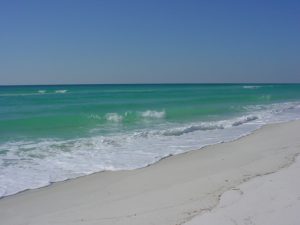
Life on the Gulf Coast can be beautiful, but has its share of complications. Photo credit: Carrie Stevenson, UF IFAS Extension
Life on the coast has tremendous benefits; steady sea breezes, gorgeous beaches, plentiful fishing and paddling opportunities. Nevertheless, there are definite downsides to living along it, too. Besides storms like Hurricane Harvey making semi-regular appearances, our proximity to the water can make us more vulnerable to flooding and waterborne hazards ranging from bacteria to jellyfish. One year-round problem for those living directly on a shoreline is erosion. Causes for shoreline erosion are wide-ranging; heavy boat traffic, foot traffic, storms, lack of vegetation with anchoring roots, and sea level rise.
Many homeowners experiencing loss of property due to erosion unwittingly contribute to it by installing seawalls. When incoming waves hit the hard surface of the wall, energy reflects back and moves down the coast. Often, an adjacent homeowner will experience increased erosion and bank scouring after a neighboring property installs a seawall. This will often lead that neighbor to install a seawall themselves, transferring the problem further.
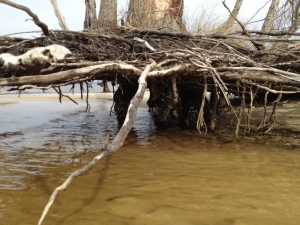
Erosion can damage root systems of shoreline trees and grasses. Photo credit: Carrie Stevenson, UF IFAS Extension
Currently, south Louisiana is experiencing significant coastal erosion and wetlands losses. The problem is compounded by several factors, including canals dredged by oil companies, which damage and break up large patches of the marsh. Subsidence, in which the land is literally sinking under the sea, is happening due to a reduced load of sediment coming down the Mississippi River. Sea level rise has contributed to erosion, and most recently, an invasive insect has caused large-scale death of over 100,000 acres of Roseau cane (Phragmites australis). Add the residual impacts from the oil spill, and you can understand the complexity of the situation.
Luckily, there are ways to address coastal erosion, on both the small and large scale. On Gulf and Atlantic beaches, numerous coastal communities have invested millions in beach renourishment, in which offshore sand is barged to the coast to lengthen and deepen beaches. This practice, while common, can be controversial because of the cost and risk of beaches washing out during storms and regular tides. However, as long as tourism is the #1 economic driver in the state, the return on investment seems to be worth it.
On quieter waters like bays and bayous, living shorelines have “taken root” as a popular method of restoring property and stabilizing shorelines. This involves planting marsh grasses along a sandy shore, often with oyster or rock breakwaters placed waterward to slow down wave energy, and allow newly planted grasses to take root.
Locally in Bayou Grande, a group of neighbors were experiencing shoreline erosion. Over a span of 50 years, the property owners used a patchwork of legally installed seawalls, bulkheads, rip rap piles, private boat ramps, piers, mooring poles and just about anything else one can imagine, to reduce the problem. Over time, the seawalls and bulkheads failed, lowering the property value of the very property they were meant to protect and increasing noticeable physical damage to the adjacent properties.”
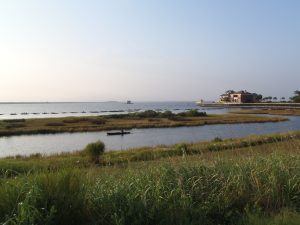
Project Greenshores is a large-scale living shoreline project in Pensacola. Photo credit: Carrie Stevenson, UF IFAS Extension
In 2011, a group of neighboring property owners along the bayou decided to take action. After considering many repair options, the neighbors decided to pursue a living shoreline based on aesthetics, long-term viability, installation cost, maintenance cost, storm damage mitigation and feasibility of installation. By 2017, the living shoreline was constructed. Oyster shell piles were placed to slow down wave energy as it approached the transition zone from the long fetch across the bayou, while uplands damage was repaired and native marsh grasses and uplands plants were restored to slow down freshwater as it flowed towards the bayou. Sand is now accruing as opposed to eroding along the shoreline. Wading shorebirds are now a constant companion and live oysters are appearing along the entire 1,200-foot length. Additionally the living shoreline solution provided access to resources, volunteer help, and property owner sweat equity opportunities that otherwise would have been unavailable. An attribute that has surprisingly appeared – waterfront property owners are now able to keep their nicely manicured lawns down to within 30 feet of the water’s edge. At that point, the landscape immediately switches back to native marsh plants, which creates a quite robust and attractive intersection. (Text and information courtesy Charles Lurton).
Successes like these all over the state have led the Florida Master Naturalist Program to offer a new special topics course on “Coastal Shoreline Restoration” which provides training in the restoration of living shorelines, oyster reefs, mangroves, and salt marsh, with focus on ecology, benefits, methods, and monitoring techniques. Keep an eye out for this course being offered near you. If you are curious about living shorelines and want to know more, reach out to the Florida Department of Environmental Protection Ecosystem Restoration section for help and read through this online document.
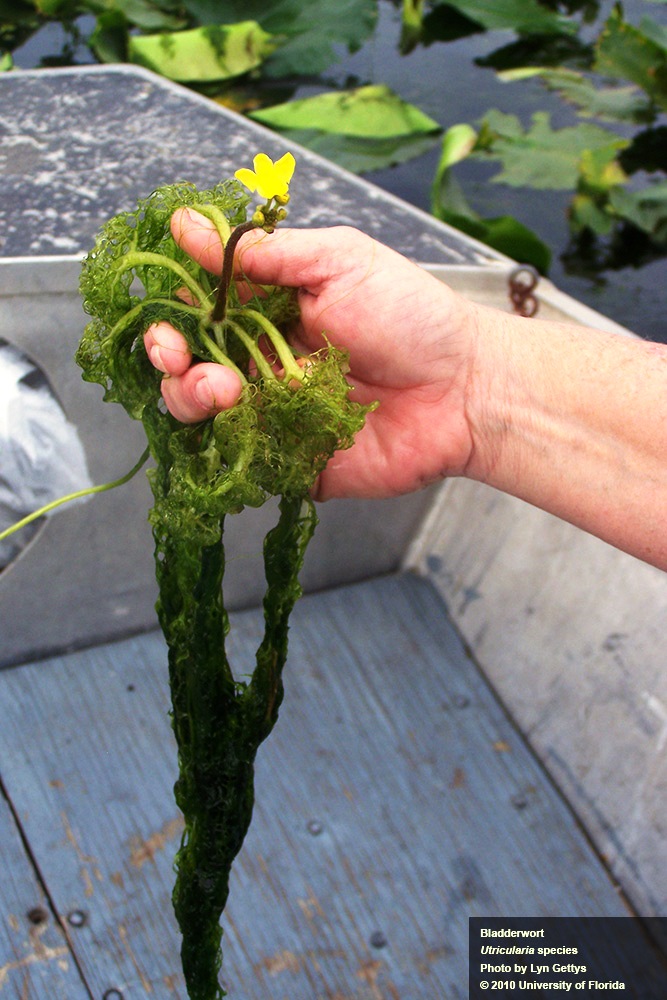
by Judy Biss | Jun 3, 2016

DId you know that Florida is home to 14 species of aquatic carnivorous plants called “bladderworts?” This one is Utricularia inflata. Photo by Lyn Gettys
I don’t know about you, but living in “La Florida” – “the land of flowers” (the Spanish translation of Florida – named in 1513 by Spanish explorer Juan Ponce de León) makes it difficult to have a short list of favorite plants. While I do have a number of plants in my “favorites” list, carnivorous plants are always at the top in the “wow, is that real?” category! Many people have read about, or have seen the carnivorous pitcher plant communities in Florida panhandle bogs, meadows, and seepage slopes, but did you also know that Florida is home to 14 species of aquatic carnivorous plants called “bladderworts?”
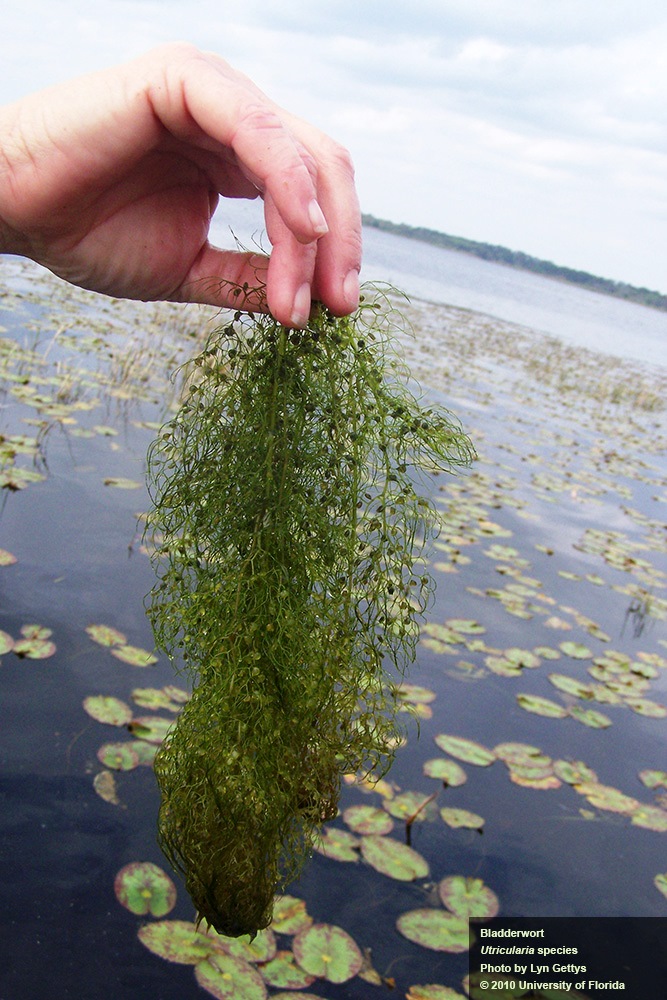
Utricularia’s many small bladders (only a few millimeters in size, and seen in this photo as small dark spots) actually trap and digest tiny aquatic invertebrates! Photo by Lyn Gettys
These bladderworts are in the genus Utricularia whose Latin meaning, “little bag,” is descriptive of the many small bladders (only a few millimeters in size) on the plant which actually trap and digest tiny aquatic invertebrates! Bladderworts are found in lakes, ponds, wetlands, and quiet coves of rivers and streams. They are commonly found in waters with low pH and low nutrients. One interesting fact is that bladderworts do not have roots. They have main stems from which lacy, intricate leaves grow. Like other plants, bladderworts produce food by photosynthesis; but the trapped invertebrates supplement the nutritional requirements of this plant. The Botanical Society of America reports that currently 220 species of Utricularia are found in temperate and tropical habitats throughout the world representing the most diverse and widespread genus of carnivorous plants.

A close-up of the tiny Utricularia bladders. Photo by Sturgis McKeever, Georgia Southern University, Bugwood.org
Similar to a Venus fly trap, hairs on the opening of the bladder act as triggers. When tiny prey swim by and contact these hairs, it causes the bladder to spring open and inflate, drawing in water and prey like a vacuum. Research has found that bacteria living in the traps act together in a mutualistic role to digest the food trapped in the bladders. An article in the Journal of Experimental Botany entitled “The carnivorous bladderwort (Utricularia, Lentibulariaceae): a system inflates,” details another fascinating aspect of these plants: the bladders often look like the tiny prey (microcrustaceans/cladocerans) they are catching.
“Darwin (1875), noted yet another insight: aquatic Utricularia bladders bear a striking resemblance to microcrustaceans. The bladder shape, surface reticulations, stalk, and especially the antennae and bristles resemble microcrustacean anatomy. Interestingly, the bladders most closely resemble the littoral zone cladocerans (bosminids and chydorids) that are frequently found or overrepresented in bladders (Guiral and Rougier, 2007; Alkhalaf et al., 2009)….Moreover, experiments reveal that the cladoceran-like structures of bladders significantly improve the capture rates of cladocerans (Meyers and Strickler, 1979; Harms, 1999; Jobson and Morris, 2001).”
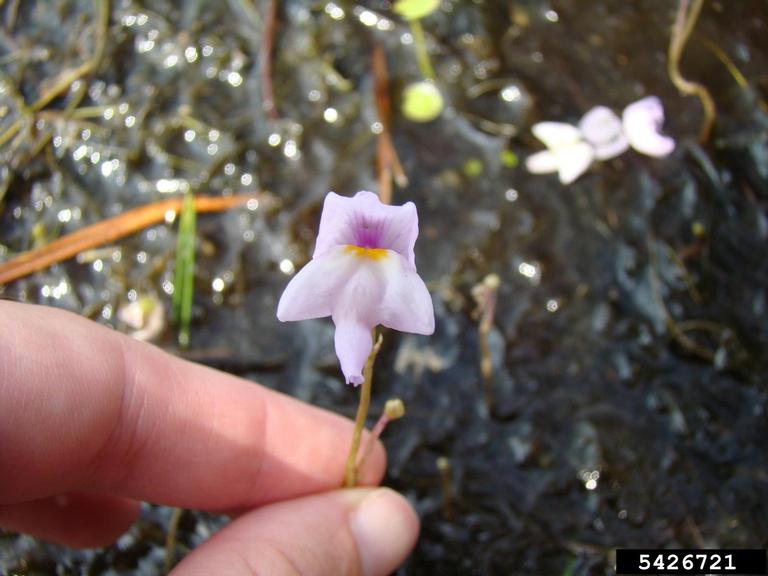
Bladderwort flowers are small but beautiful, and are designed to maximize pollination. This is purple bladderwort (Utricularia purpurea). Photo by Rebekah D. Wallace, University of Georgia, Bugwood.org
Bladderwort flowers are another beautiful feature of this plant. In Florida most species have yellow flowers, some are lavender to purple. The flowers bloom several inches above the water, and their shape is designed to efficiently attract and remove pollen from pollinating insects like bees. Part of the flower is shaped like a spur which contains a nectar reward for pollinating insects. This link, The Utricularia, to a Botanical Society of America publication details the botany and pollination ecology of bladderworts.
We hope this article piques your curiosity about some of Florida’s obscure native, aquatic, carnivorous plants! Maybe you, too, will include them in your list of favorite La Florida plants!
Below are the publications used for this article:
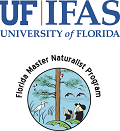
by Chris Verlinde | Jan 19, 2016
 The mission of the Florida Master Naturalist program (FMNP) is to promote awareness, understanding and respect of Florida’s natural environment. FMNP graduates, Paul Bennett and Charlie Lurton have both worked diligently through the permitting process to place living shorelines consisting of oyster shell bags and marsh plants along their coastal properties.
The mission of the Florida Master Naturalist program (FMNP) is to promote awareness, understanding and respect of Florida’s natural environment. FMNP graduates, Paul Bennett and Charlie Lurton have both worked diligently through the permitting process to place living shorelines consisting of oyster shell bags and marsh plants along their coastal properties.
Living Shorelines incorporate a range of natural structures to protect coastal shorelines from erosion and enhance habitat for wildlife. Oyster shell bags, biologs, plants and sand fill may be used or a combination of natural materials may be used in a living shoreline project. These projects provide “soft” shoreline protection that offers economic and ecological benefits to the property owner. They are recommended for use in low wave and erosional settings.
In higher wave energy areas, seawalls and bulkheads may be required for shoreline protection. These types of projects “harden” the shoreline, and do not allow for intertidal habitat and eliminate the natural slope of the shoreline. Hard structure projects can have a detrimental effect on nearby properties as wave energy is deflected from the structure and can increase erosion nearby, alter sand movement and decrease intertidal habitat.
Both Mr. Bennet and Mr. Lurton realized the importance and benefits of shoreline protection using natural materials, both men attributed this knowledge to their experiences in the FMNP. The FMNP graduates worked with the local branch of the Florida Department of Environmental Protection’s (DEP) Florida Coastal Office, Northwest Florida Aquatic Preserves, to obtain funding and permits for the projects. DEP’s Florida Coastal Office has worked with the US Fish and Wildlife Services’ Coastal Program to promote and support living shoreline projects across the Panhandle.
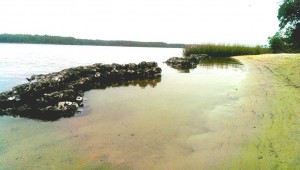
Oyster reef breakwater along the Shoreline of Bayou Grande, Charlie Lurton’s project. Photo credit: Zachary Shang
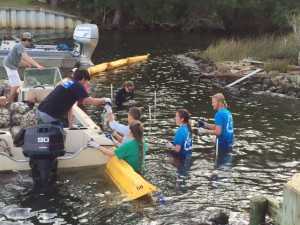
Installing the oyster reef breakwater along the shoreline of Paul Bennett in East Bay, Santa Rosa County, FL. Photo Credit: Beth Fugate
Mr. Lurton worked with seven of his neighbors to create 1,200 linear feet of shoreline. This project on Bayou Grande in Escambia County incorporated 39 oyster reefs, each built of 200 bags of recycled oyster shells. Each bag of recycled oyster shell weighs approximately twenty pounds for a total of 78 tons of shell! 11,300 native grasses and salt tolerant plants will be installed along the shoreline this year.
Mr. Bennet’s project along East Bay in Santa Rosa County consists of 5 reefs built along the mouth of a freshwater marsh located on his property for a total of 10 tons of shell. DEP’s Florida Coastal Office will determine if native grasses and plants are needed for the project in the future.
“The conversation for both of these projects started years before we were able install any materials so it’s rewarding to see them take hold,” said Zachary Schang, environmental specialist with the Northwest Florida Aquatic Preserves. “It was in large part due to the persistence of the property owners who wanted to deal with a natural problem using a natural solution.”
These types of habitat restoration projects allow for ecological and economic benefits for the property owners. The Fl. Master Naturalist Program promotes understanding and awareness of natural resources, these two graduates have demonstrated what it means to be a FMN.
Watch this newsletter for more about the FMNP and FMNP graduates. For more information about the FMNP and classes being offered in your area, check out http://www.masternaturalist.ifas.ufl.edu/.























